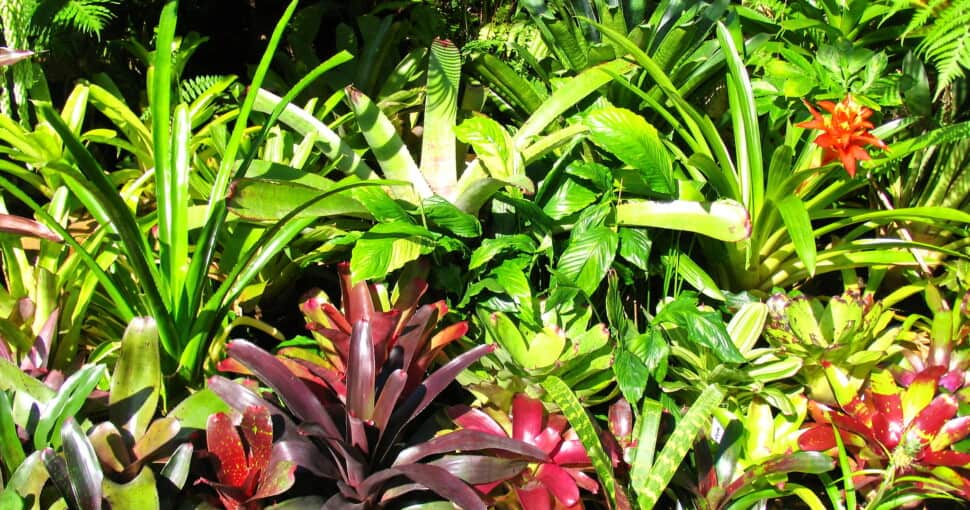Bromeliads are versatile plants that can grow as aerophytes (air plants), epiphytes (on trees), lithophytes (on rocks), or in the ground like regular plants. Bromeliads, with a few exceptions, only bloom once in their lifetime.
Contents
Bromeliads have green, silvery grey, striped or variegated foliage. The leaves form an eye-catching feature without the presence of the flower. Bromeliads have sword or strap-shaped leaves that form a cup where they attach to the stem.
Bromeliads live for three to five years and form a single flower towards the end of their lives. The unusual, attractive flowers are brightly colored. They may be pink, red, orange, or purple. Some flowers have yellow or white centers.
The flowers of some species resemble the leaves that grow on the top of a pineapple. In others, the flower may be cone-shaped, and in others, there may be a long flower spike.
The flower blooms for six months to a year, after which it wilts, and the plant dies. Fortunately, before the bromeliad dies, it produces new plantlets, known as pups.
Bromeliads have a unique appearance, and finding plants that resemble them can be challenging. These are some plants that look similar to bromeliads:
- Pineapple
- Rosette sword plant
- Ribbon Grass
- Joseph’s coat plant
- Agave xylonacantha ‘Frostbite’
- Agave lophantha “Quadricolor’
- Pineapple Lilies
- Silver Vase Plant
- Quesnelia
1. Pineapple
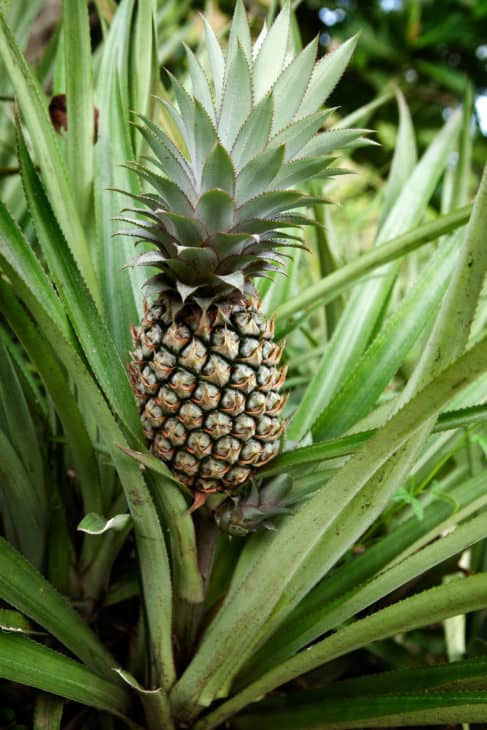
Pineapples grow in tropical regions. They belong to the Bromeliaceae family, which is the same as bromeliads. It is not surprising, then, that pineapples look like bromeliads.
Pineapple plants grow three to four feet tall. They produce solid green or variegated leaves, much like bromeliads. The leaves grow in a tight spiral or rosette, similar to bromeliads. The cultivar determines the color of the leaves. The leaves have sharp spines on the edges, which have pierced many unwary gardeners.
Pineapples produce brightly colored flowers surrounded by colored bracts, like bromeliads. Unlike bromeliads, pineapples produce many flowers each fruiting season. The flowers give rise to pineapples that perch on the colored bracts.
Related: 7 Plants That Look Like Pineapples
2. Rosette Sword Plant
Rosette sword plants (Echidnodorus parviflorus) are plants that grow with the same rosette leaf arrangement as bromeliads. They have bright green textured leaves with smooth margins. The leaves are smaller than bromeliad leaves, and the maximum height for the plant is six inches.
Rosette sword plants grow in water, marshes, or on the edges of ponds. They produce small blue flowers, but the occurrence of flowers depends on the growing environment. The flowers are very different from bromeliad blossoms.
3. Ribbon Grass
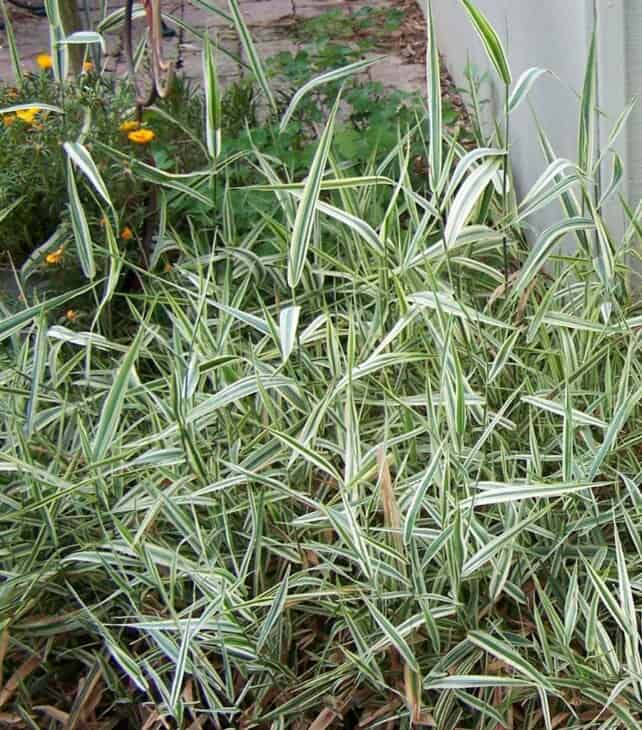
Ribbon grass (Phalaris arundinacea) belongs to the family Poaceae. It is also called reed canary grass or gardener’s garters. It grows in wetlands and along the edges of streams and rivers, where it can grow up to six feet tall but is usually only one to two feet.
Ribbon grass has sword or strap-like leaves that grow around a central stem. The leaves may be a solid color or variegated. The variegate ribbon grass closely resembles the leaves of variegated bromeliads.
Ribbon grass produces small flower spikelets in summer. These flowers may be tan, pink, brown, or cream-colored. The flowers give rise to seeds that allow the plant to spread rapidly.
4. Joseph’s Coat Plant
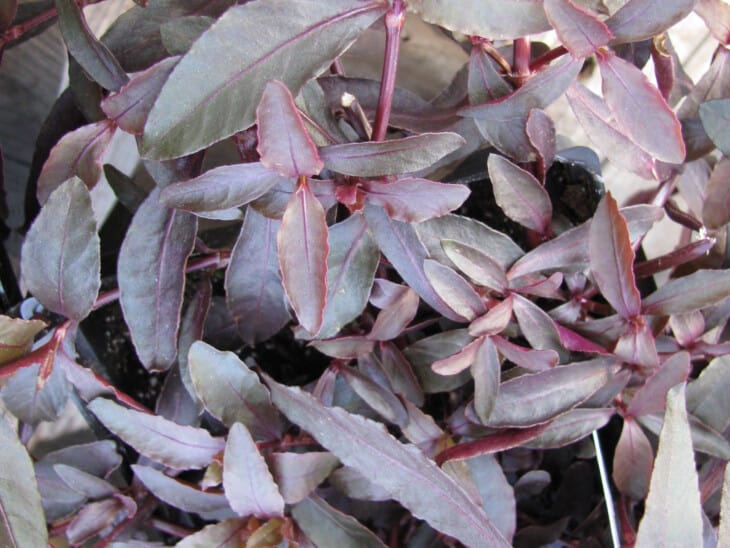
Joseph’s coat (Alternanthera dentata) is part of the Amaranthaceae or buckwheat family. They grow from six inches to one foot and can spread to two feet wide. These plants occur naturally in the West Indies and South America.
Joseph’s coat plants have numerous cultivars. Their leaves vary in shape from oval to lance-shaped. They are popular for the color variation in the leaves. They can be red, purple, burgundy, or multicolored.
Many Joseph’s coat plants have bright red, yellow, and green leaves, giving the impression of bright ‘flowers’ occurring in the grass. This characteristic makes Joseph’s coat look similar to bromeliads.
Joseph’s coat plants produce insignificant cream, white or green flowers in summer. They can be grown in containers or garden beds.
5. Agave Xylonacantha ‘Frostbite’
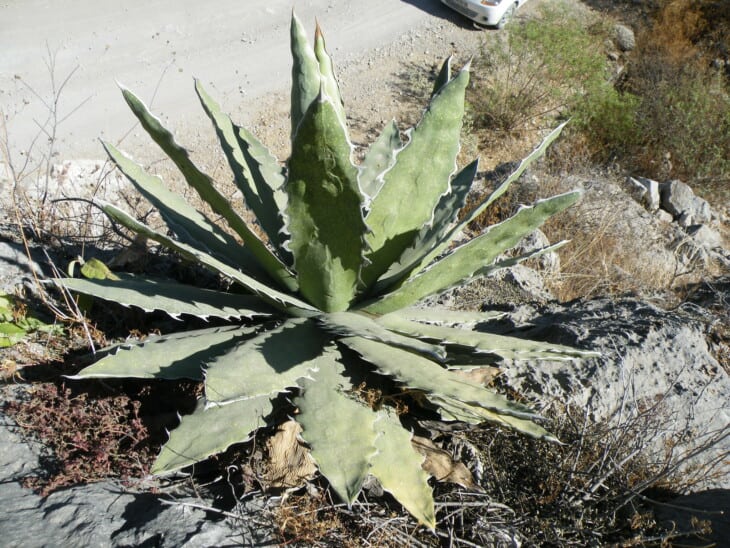
Agave xyloncantha ‘Frostbite’ is classified under the Asparagaceae family. They are indigenous to Mexico and are favored by gardeners who like bold foliage.
Agave xylonacantha ‘frost bite’ has stiff, rigid leaves that grow in a rosette around a central stem, much like bromeliads. The leaves have woody spines on their margins, making them a plant to handle with care.
The leaves have a central green strip with creamy yellow edges. Agave xylonacantha leaves can grow to eighteen inches long. They grow slowly and only produce flowers after fifteen to twenty years. The pale green or yellowish flowers bloom at the end of an eleven feet tall spike.
Related: 6 Plants That Look Like Agave
6. Agave Lopahantha ‘Quadricolor’
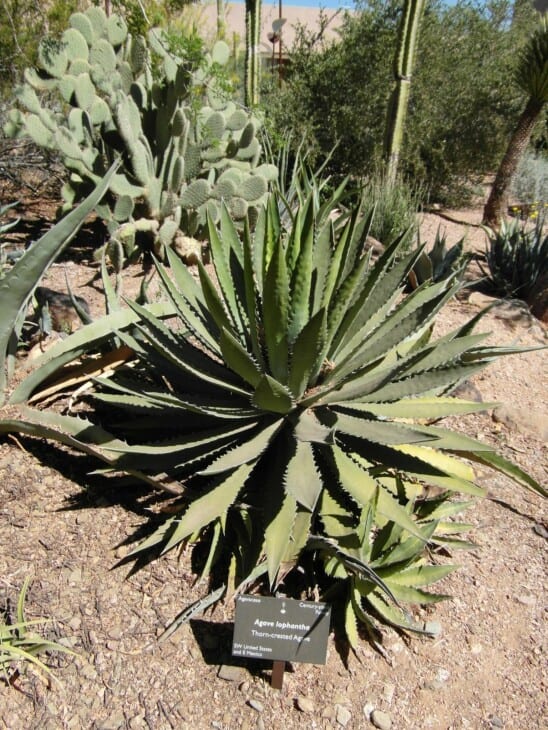
Agave lopahantha ‘Quadricolor’ is another agave that looks similar to bromeliads. It grows in a rosette and has attractive leaves. The leaves have a central light green stripe outlined by a thin dark green region which in turn is surrounded by a creamy yellow border.
The leaf margins have teeth that are often reddish. The color of the teeth varies according to the amount of light the plant receives. They become redder with increased light. The plant then has four colors, light green, dark green, yellow, and red, giving rise to its name ‘Quadricolor.’
Agaves are heat and drought-tolerant but do best with regular watering in summer. They are a good alternative to bromeliads in hot, dry climates.
7. Pineapple Lilies
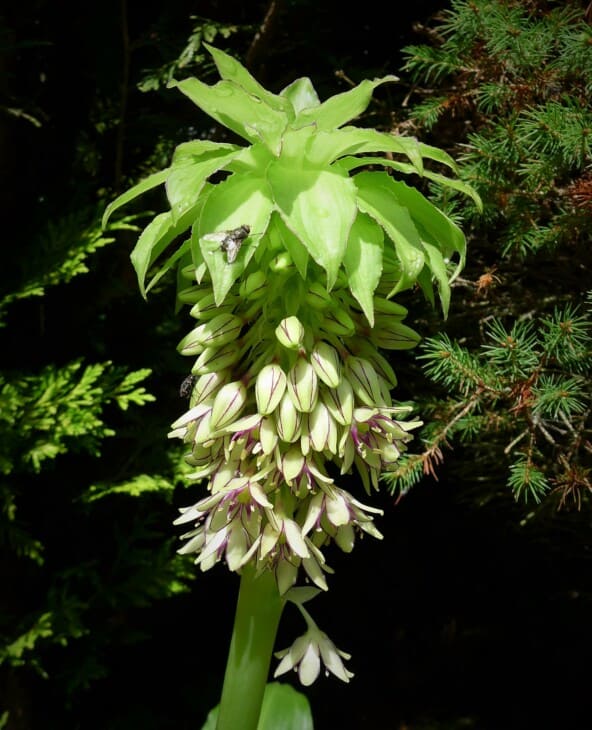
Pineapple lilies (Eucomis comosa) are from the Asparagaceae family that grows indigenously in South Africa. The leaves grow as a rosette around the base of the plant. They are green or deep red, and some have purple spots or a purplish tinge.
The leaves are lance-shaped and have undulating margins and a clear midrib. The rosette arrangement of the leaves makes pineapple lilies similar to bromeliads.
They grow a tall flower spike in summer. The white, pink, or purple flowers are surrounded by green bracts. The flowers have a sweet coconut scent.
8. Silver Vase Plant
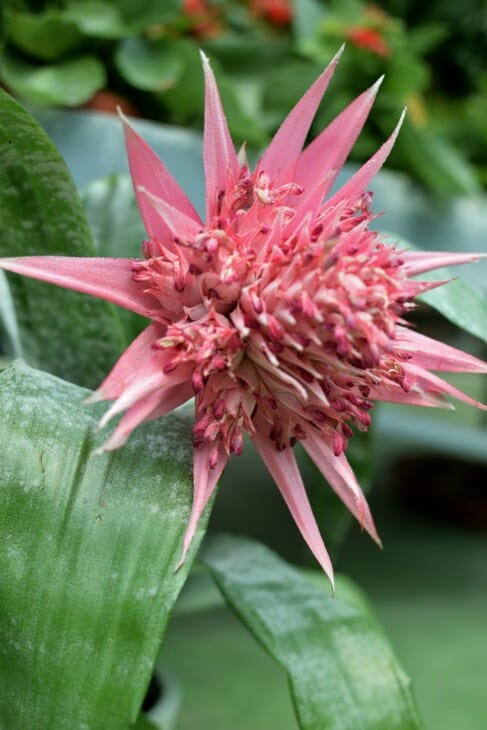
The silver vase plant (Aechmea fasciata) belongs to the Bromeliaceae family. It is sometimes called the urn plant. This slow-growing plant can reach thirty-five inches in height and spread to twenty-four inches wide.
The elongated oval leaves are eighteen to thirty-five inches long and are usually green with horizontal slivery smudged lines. The leaves grow in a basal rosette like bromeliads. The rosette fills with water which the plant uses. This characteristic allows the silver vase plant to grow on other trees or in the soil.
Silver vase plants produce rosette-shaped flowers that are usually rosy pink or violet. The flower is formed by modified bracts that surround the true flowers. The true flowers are tiny blue blossoms that occur between the brightly-colored bracts. The flowers bloom for approximately six months.
9. Quesnelia
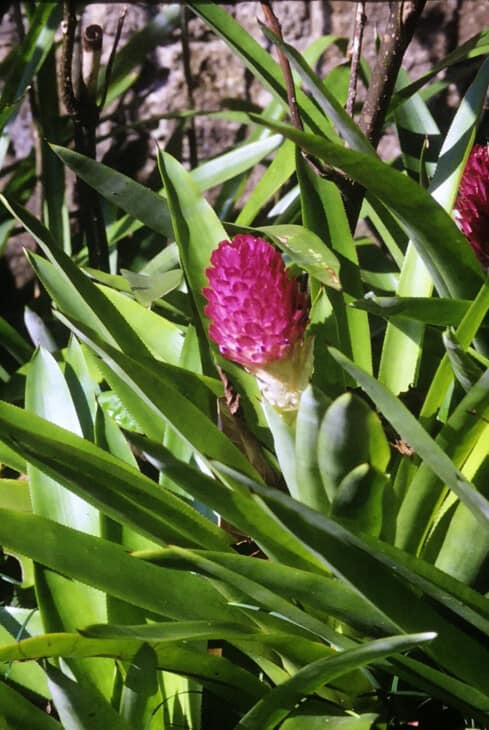
Quesnelia is also a member of the bromeliad family. As with most plants in this family, the leaves grow in a rosette from the base of the plant. They are thick fleshy leaves that look almost like succulents. Quesnelia have bright green leaves with smooth or serrated margins. Some species have eye-catching mahogany red or spotted leaves.
Quesnelias produce brightly colored flowers that consist of true flowers and modified bracts similar to bromeliads. The flowers may be hot pink, blue, purple, yellow, orange, or a combination of colors. In some cultivars, the flower bracts flare outward at the tip.
Quesnelias grow to two to three feet tall. They are drought and cold-tolerant, making them popular with gardeners. They grow in full sun and partial shade, depending on the climate.

